window SKODA OCTAVIA TOUR 2010 1.G / (1U) Columbus Navigation System Manual
[x] Cancel search | Manufacturer: SKODA, Model Year: 2010, Model line: OCTAVIA TOUR, Model: SKODA OCTAVIA TOUR 2010 1.G / (1U)Pages: 207, PDF Size: 12.63 MB
Page 79 of 207
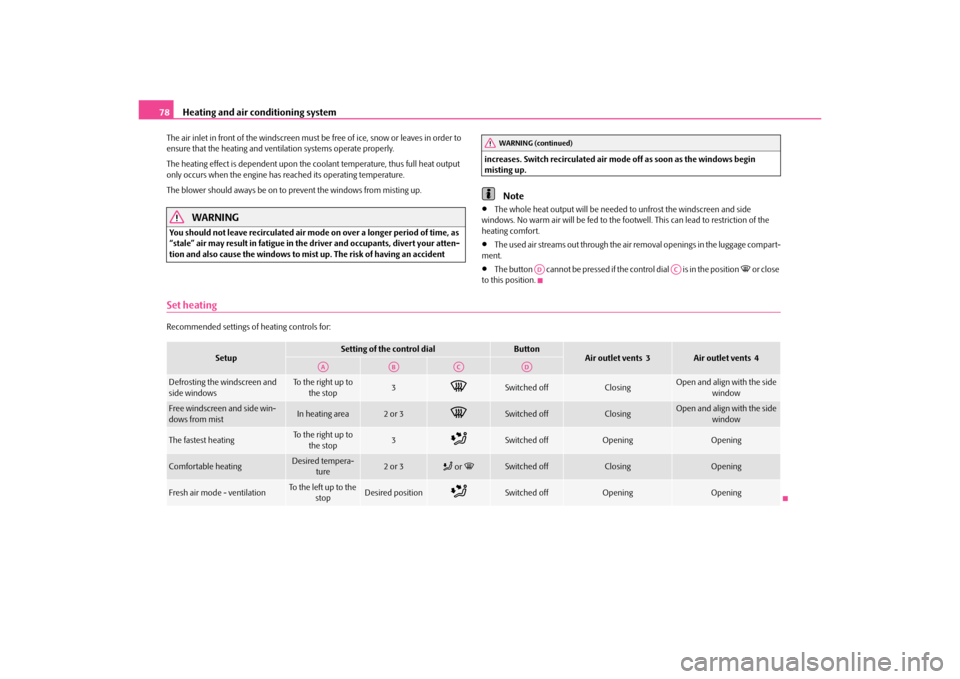
Heating and air conditioning system
78
The air inlet in front of the windscreen must be free of ice, snow or leaves in order to
ensure that the heating and ventilation systems operate properly.
The heating effect is dependent upon the c oolant temperature, thus full heat output
only occurs when the engine has reached its operating temperature.
The blower should aways be on to prevent the windows from misting up.
WARNING
You should not leave recirculated air mode on over a longer period of time, as
“stale” air may result in fatigue in the driver and occupants, divert your atten-
tion and also cause the windows to mist up. The risk of having an accident increases. Switch recirculated air mo
de off as soon as the windows begin
misting up.
Note
The whole heat output will be needed to unfrost the windscreen and side
windows. No warm air will be fed to the footwell. This can lead to restriction of the
heating comfort.
The used air streams out through the air removal openings in the luggage compart-
ment.
The button cannot be pressed if the control dial is in the position
or close
to this position.
Set heatingRecommended settings of heating controls for:
WARNING (continued)
AD
AC
Setup
Setting of the control dial
Button
Air outlet vents 3
Air outlet vents 4
Defrosting the windscreen and
side windows
To the right up to
the stop
3
Switched off
Closing
Open and align with the side window
Free windscreen and side win-
dows from mist
In heating area
2 or 3
Switched off
Closing
Open and align with the side
window
The fastest heating
To the right up to the stop
3
Switched off
Opening
Opening
Comfortable heating
Desired tempera- ture
2 or 3
or
Switched off
Closing
Opening
Fresh air mode - ventilation
To the left up to the
stop
Desired position
Switched off
Opening
Opening
AA
AB
AC
AD
s2rc.book Page 78 Thursd ay, April 22, 2010 10:58 AM
Page 80 of 207
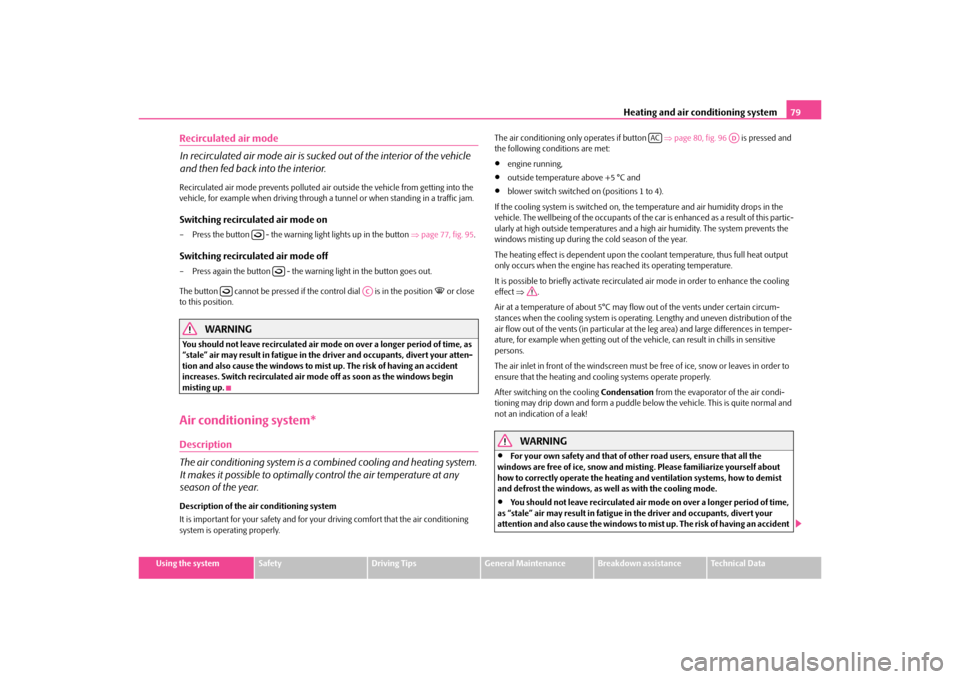
Heating and air conditioning system79
Using the system
Safety
Driving Tips
General Maintenance
Breakdown assistance
Technical Data
Recirculated air mode
In recirculated air mode air is sucked out of the interior of the vehicle
and then fed back into the interior.Recirculated air mode prevents polluted air outside the vehicle from getting into the
vehicle, for example when driving through a tunnel or when standi ng in a traffic jam.Switching recirculated air mode on– Press the button - the warning light lights up in the button page 77, fig. 95 .Switching recirculated air mode off– Press again the button - the warning light in the button goes out.
The button cannot be pressed if the control dial is in the position
or close
to this position.
WARNING
You should not leave recirculated air mode on over a longer period of time, as
“stale” air may result in fatigue in the driver and occupants, divert your atten-
tion and also cause the windows to mist up. The risk of having an accident
increases. Switch recirculated air mode off as soon as the windows begin
misting up.Air conditioning system*Description
The air conditioning system is a combined cooling and heating system.
It makes it possible to optimally control the air temperature at any
season of the year.Description of the air conditioning system
It is important for your safety and for your driving comfort that the air conditioning
system is operating properly. The air conditioning only operates if button
page 80, fig. 96 is pressed and
the following conditions are met:
engine running,
outside temperature above +5 °C and
blower switch switched on (positions 1 to 4).
If the cooling system is switched on, the temperature and air humidity drops in the
vehicle. The wellbeing of the occupants of the car is enhanced as a result of this partic-
ularly at high outside temperatures and a high air humidity. The system prevents the
windows misting up during the cold season of the year.
The heating effect is dependent upon the c oolant temperature, thus full heat output
only occurs when the engine has reached its operating temperature.
It is possible to briefly activate recirculat ed air mode in order to enhance the cooling
effect .
Air at a temperature of about 5°C may flow out of the vents under certain circum-
stances when the cooling system is operating. Lengthy and uneven distribution of the
air flow out of the vents (in particular at the leg area) and large differences in temper-
ature, for example when getting out of the ve hicle, can result in chills in sensitive
persons.
The air inlet in front of the windscreen must be free of ice, snow or leaves in order to
ensure that the heating and cooling systems operate properly.
After switching on the cooling Condensation from the evaporator of the air condi-
tioning may drip down and form a puddle be low the vehicle. This is quite normal and
not an indication of a leak!
WARNING
For your own safety and that of other road users, ensure that all the
windows are free of ice, snow and misting. Please familiarize yourself about
how to correctly operate the heating and ventilation systems, how to demist
and defrost the windows, as well as with the cooling mode.
You should not leave recirculated air mode on over a longer period of time,
as “stale” air may result in fatigue in the driver and occupants, divert your
attention and also cause the windows to mist up. The risk of having an accident
AC
AC
AD
s2rc.book Page 79 Thursd ay, April 22, 2010 10:58 AM
Page 81 of 207
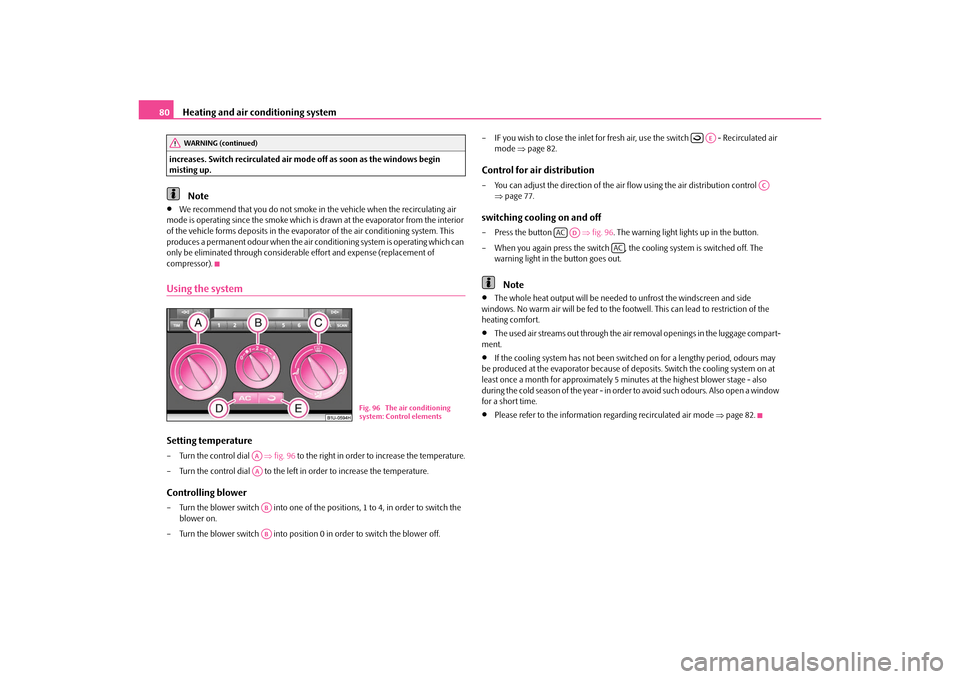
Heating and air conditioning system
80
increases. Switch recirculated air mode off as soon as the windows begin
misting up.
Note
We recommend that you do not smoke in the vehicle when the recirculating air
mode is operating since the smoke which is drawn at the evaporator from the interior
of the vehicle forms deposits in the evapor ator of the air conditioning system. This
produces a permanent odour when the air conditioning system is operating which can
only be eliminated through considerable effort and expense (replacement of
compressor).
Using the systemSetting temperature– Turn the control dial fig. 96 to the right in order to increase the temperature.
– Turn the control dial to the left in order to increase the temperature.Controlling blower– Turn the blower switch into one of the po sitions, 1 to 4, in order to switch the
blower on.
– Turn the blower switch into position 0 in order to switch the blower off. – IF you wish to close the inlet for fresh air, use the switch - Recirculated air
mode page 82.
Control for air distribution– You can adjust the direction of the air flow using the air distribution control
page 77.switching cooling on and off– Press the button fig. 96 . The warning light lights up in the button.
– When you again press the switch , the cooling system is switched off. The warning light in the button goes out.
Note
The whole heat output will be needed to unfrost the windscreen and side
windows. No warm air will be fed to the footwell. This can lead to restriction of the
heating comfort.
The used air streams out through the air removal openings in the luggage compart-
ment.
If the cooling system has not been switched on for a lengthy period, odours may
be produced at the evaporator because of deposits. Switch the cooling system on at
least once a month for approximately 5 minutes at the highest blower stage - also
during the cold season of the year - in order to avoid such odours. Also open a window
for a short time.
Please refer to the information regarding recirculated air mode page 82.
WARNING (continued)
Fig. 96 The air conditioning
system: Control elements
AAAAABAB
AE
AC
AC
AD
AC
s2rc.book Page 80 Thursd ay, April 22, 2010 10:58 AM
Page 82 of 207
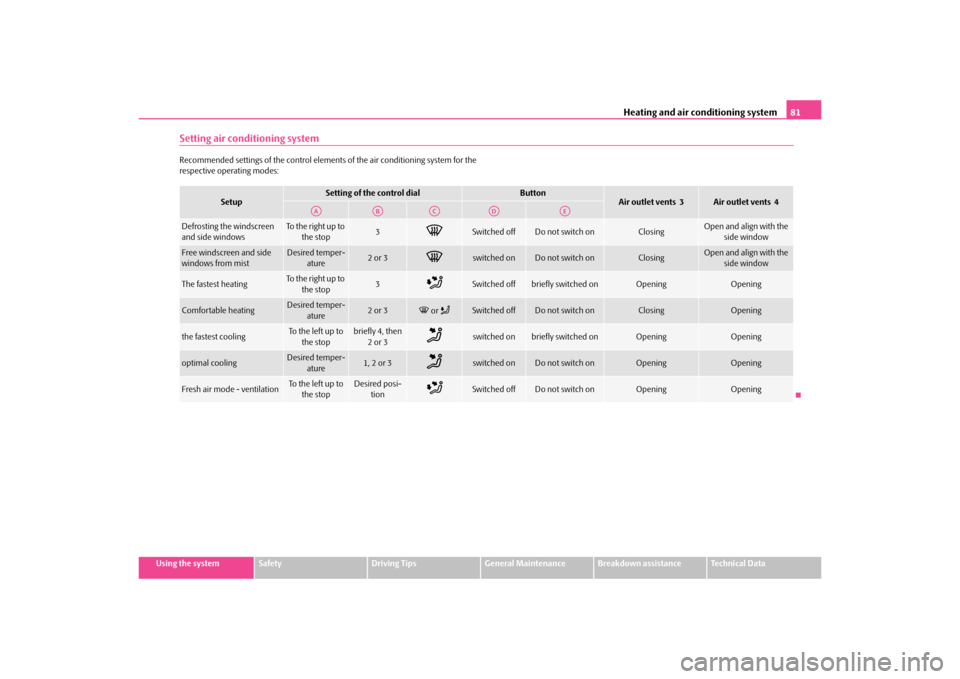
Heating and air conditioning system81
Using the system
Safety
Driving Tips
General Maintenance
Breakdown assistance
Technical Data
Setting air conditioning systemRecommended settings of the control elements of the air conditioning system for the
respective operating modes:
Setup
Setting of the control dial
Button
Air outlet vents 3
Air outlet vents 4
Defrosting the windscreen
and side windows
To the right up to
the stop
3
Switched off
Do not switch on
Closing
Open and align with the side window
Free windscreen and side
windows from mist
Desired temper- ature
2 or 3
switched on
Do not switch on
Closing
Open and align with the side window
The fastest heating
To the right up to
the stop
3
Switched off
briefly switched on
Opening
Opening
Comfortable heating
Desired temper- ature
2 or 3
or
Switched off
Do not switch on
Closing
Opening
the fastest cooling
To the left up to the stop
briefly 4, then 2or 3
switched on
briefly switched on
Opening
Opening
optimal cooling
Desired temper-
ature
1, 2 or 3
switched on
Do not switch on
Opening
Opening
Fresh air mode - ventilation
To the left up to the stop
Desired posi- tion
Switched off
Do not switch on
Opening
Opening
AA
AB
AC
AD
AE
s2rc.book Page 81 Thursd ay, April 22, 2010 10:58 AM
Page 83 of 207
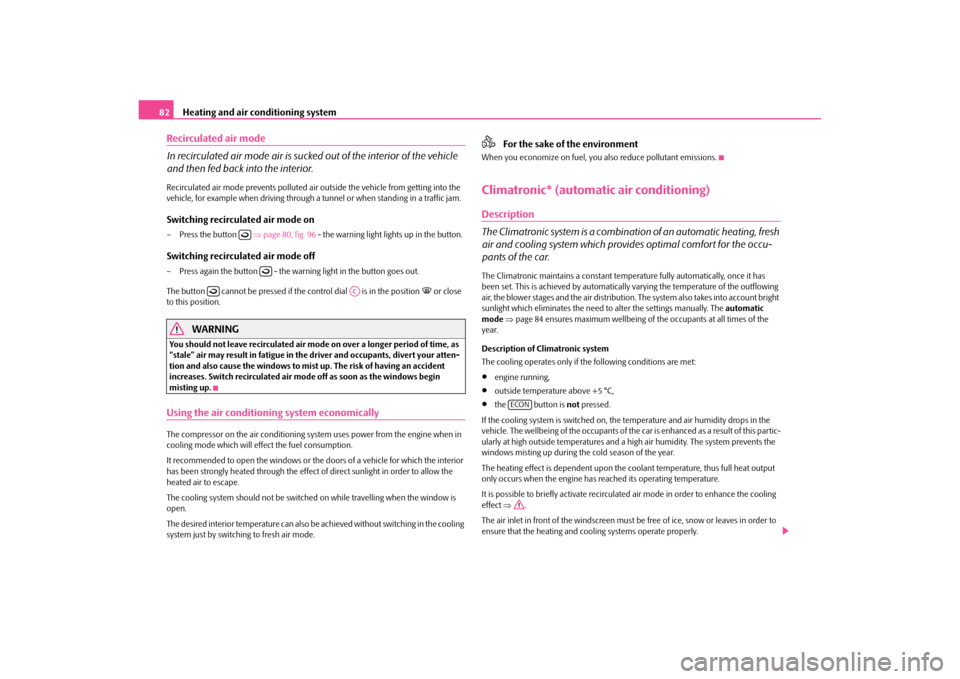
Heating and air conditioning system
82
Recirculated air mode
In recirculated air mode air is sucked out of the interior of the vehicle
and then fed back into the interior.Recirculated air mode prevents polluted air outside the vehicle from getting into the
vehicle, for example when driving through a tunnel or when standi ng in a traffic jam.Switching recirculated air mode on– Press the button page 80, fig. 96 - the warning light lights up in the button.Switching recirculated air mode off– Press again the button - the warning light in the button goes out.
The button cannot be pressed if the control dial is in the position
or close
to this position.
WARNING
You should not leave recirculated air mode on over a longer period of time, as
“stale” air may result in fatigue in the driver and occupants, divert your atten-
tion and also cause the windows to mist up. The risk of having an accident
increases. Switch recirculated air mode off as soon as the windows begin
misting up.Using the air conditioning system economicallyThe compressor on the air conditioning syst em uses power from the engine when in
cooling mode which will effect the fuel consumption.
It recommended to open the windows or the doors of a vehicle for which the interior
has been strongly heated through the effect of direct sunlight in order to allow the
heated air to escape.
The cooling system should not be switched on while travelling when the window is
open.
The desired interior temperature can also be achieved without switching in the cooling
system just by switching to fresh air mode.
For the sake of the environment
When you economize on fuel, you also reduce pollutant emissions.Climatronic* (automatic air conditioning)Description
The Climatronic system is a combinat ion of an automatic heating, fresh
air and cooling system which provides optimal comfort for the occu-
pants of the car.The Climatronic maintains a constant temp erature fully automatically, once it has
been set. This is achieved by automatically varying the temperature of the outflowing
air, the blower stages and the air distribution. The system also takes into account bright
sunlight which eliminates the need to alter the settings manually. The automatic
mode page 84 ensures maximum wellbeing of the occupants at all times of the
year.
Description of Climatronic system
The cooling operates only if the following conditions are met:
engine running,
outside temperature above +5 °C,
the button is not pressed.
If the cooling system is switched on, th e temperature and air humidity drops in the
vehicle. The wellbeing of the occupants of the car is enhanced as a result of this partic-
ularly at high outside temperatures and a high air humidity. The system prevents the
windows misting up during the cold season of the year.
The heating effect is dependent upon the coolant temperature, thus full heat output
only occurs when the engine has reached its operating temperature.
It is possible to briefly activate recirculat ed air mode in order to enhance the cooling
effect .
The air inlet in front of the windscreen must be free of ice, snow or leaves in order to
ensure that the heating and cooling systems operate properly.
AC
ECON
s2rc.book Page 82 Thursd ay, April 22, 2010 10:58 AM
Page 84 of 207

Heating and air conditioning system83
Using the system
Safety
Driving Tips
General Maintenance
Breakdown assistance
Technical Data
The AC compressor is switched off at a hi
gh coolant temperature in order to provide
cooling at a high load of the engine.
After switching on the cooling Condensation from the evaporator of the air condi-
tioning may drip down and form a puddle be low the vehicle. This is quite normal and
not an indication of a leak!
If you make a change before switching off the ignition, which differs from the auto-
matic mode, the changed functi ons remain stored. Only the function “circulating air”
is erased 20 minutes after switching off the ignition.
Recommended setting for all periods of the year:
Set the temperature to 22 °C (72 °F).
Press the button page 83, fig. 97.
Move the air outlet vents 3 and 4, so that the air flow is directed slightly upwards
page 77, fig. 94 .
Switching over between degrees Celsius and degrees Fahrenheit
Press and hold the buttons 17 and 9 page 83, fig. 97 . The information
in the desired temperature measuring unit appears in the display.
WARNING
For your own safety and that of other road users, ensure that all the
windows are free of ice, snow and mistin g. Please familiarize yourself about
how to correctly operate th e heating and ventilation systems, how to demist
and defrost the windows, as well as with the cooling mode.
You should not leave recirculated air mode on over a longer period of time,
as “stale” air may result in fatigue in the driver and occupants, divert your
attention and also cause the windows to mist up. The risk of having an accident
increases. Switch recirculated air mode off as soon as the windows begin
misting up.Note
If the cooling system has not been switched on for a lengthy period, odours may
be produced at the evaporator because of deposits. Switch the cooling system on at
least once a month for approximately 5 minut es at the highest blower stage - also during the cold season of the year - in order to avoid such odours. Also open a window
for a short time.
We recommend that you do not smoke in
the vehicle when the recirculating air
mode is operating since the smoke which is drawn at the evaporator from the interior
of the vehicle forms deposits in the evapor ator of the air conditioning system. This
produces a permanent odour when the air conditioning system is operating which can
only be eliminated through considerable effort and expense (replacement of
compressor).
The used air streams out through the air removal openings in the luggage compart-
ment.
Using the cooling economically page 82.
Overview of the control elements
The controls enable a separate setting of the temperature for the left
and right side.Fig. 97 Climatronic: Control elementsThe buttons
Defrosting the windscreen
Display Display of blower stages
When switching off the automatic air cond itioning with the button 11, the outside
temperature now indicates OFF, ot her information is not indicated.
AUTO
ECON
AUTO
A1
A2A3
s2rc.book Page 83 Thursday, April 22, 2010 10:58 AM
Page 85 of 207

Heating and air conditioning system
84Defrosting the windscreen
Recirculated air mode
Direction of air flow
Display of selected inside temperature, here: +22 °C
AUTO (automatic mode), ECON (AC compressor switched off) or OFF
(Climatronic switched off)
The buttons Automatic mode
Recirculated air mode
Lower blower speed and button for switching off the air conditioning system
“OFF”
Higher blower speed and button for switching on the air conditioning system
Air flow to head
Air flow in the footwell
Decreasing the temperature
Increasing the temperature (AC compressor switched off, i.e the cooling system)
Interior temperature sensor (on le ft-hand steering models) and (on
right-hand stee ring models).Note
Do not glue or cover over th e sensor, otherwise it could have an unfavourable effect
on the Climatronic.Automatic mode
The automatic mode is used in order to maintain a constant tempera-
ture and to demist the windows in the interior of the car.Switching automatic mode on– Set a temperature between +18°C (64 °F) and +29°C (84 °F).
– Move the air outlet vents 3 and 4 page 77, fig. 94 , so that the air flow is directed
slightly upwards. – Press the button - the warning
light lights up in the button.
The automatic mode is switched off by pressing the button for the air distribution or
increasing or decreasing the blower speed. The temperature is nevertheless
regulated.
ECON mode
The cooling system is switched off in the ECON mode - heating and
ventilation are regulated automatically.Switching ECON mode on– Press the button - the warning light lights up in the button.
– Set a temperature between +18°C (64°F) and +29°C (84°F).Recirculated air mode in ECON mode– First of all press the button - the warning light lights up in the button.
– Then press the button - the warning light lights up in the button.
ECON mode operates only within the control temperature range from +18°C (64 °F)
up to +29°C (84 °F).
The ECON mode is switched off when pressing button or .
Please note that, in the ECON mode, the inte rior temperature cannot be lower than the
outside temperature. The interior is no t cooled and the air is not dehumidified.
If you select the temperature below +18°C (64°F), LO appears in the display. If you
select a temperature higher than + 29°C (84 °F), HI appears in the display. In the LO
position, the supplied air is neit her warmed up nor cooled. In the HI position, the
system operates continuously with maximum heating capacity.
Please refer to the information regarding recirculated air mode page 85.Defrosting windscreenDefrosting windscreen - switching on– Press the button page 83, fig. 97 .
A4A5A6A7A8A9
AUTO
A10
A11A12A13A14A15A16A17
ECON
A18
A18a
A18b
AUTOECON
ECON
s2rc.book Page 84 Thursd ay, April 22, 2010 10:58 AM
Page 86 of 207

Heating and air conditioning system85
Using the system
Safety
Driving Tips
General Maintenance
Breakdown assistance
Technical Data
Defrosting windscreen - switching off– Once again press the button or the button .
The temperature control is controlled automatically. More air flows out of the air outlet
vents 1 and 2.Recirculated air mode
In recirculated air mode air is sucked out of the interior of the vehicle
and then fed back into the interior.Recirculated air mode prevents polluted air outside the vehicle from getting into the
vehicle, for example when driving through a tunnel or when standi ng in a traffic jam.Switching recirculated air mode on– Press the button - the warning light lights up in the button.Switching recirculated air mode off– Press again the button or the button - the warning light in the button
goes out.
WARNING
You should not leave recirculated air mode on over a longer period of time, as
“stale” air may result in fatigue in the driver and occupants, divert your atten-
tion and also cause the windows to mist up. The risk of having an accident
increases. Switch recirculated air mode off as soon as the windows begin
misting up.
Note
If the windscreen mists up, press the button page 83, fig. 97 . After the wind-
screen has been demisted, press the button .Setting temperatureYou can set the interior temperature randomly with the buttons and . You can set the interior temperature betw
een +18°C (64°F) and +29°C (84 °F). The
interior temperature is regulated automatica lly within this range. If you select the
temperature below +18°C (64°F), “LO” appears in the display. If you select the temper-
ature higher than +29°C (84 °F ), “HI” appears in the display. In both limit positions the
Climatronic operates at ma ximum cooling or heating capacity, respectively. The
temperature is not controlled in this case.
Lengthy and uneven distribution of the air flow out of the vents (in particular at the leg
area) and large differences in temperature, for example when getting out of the
vehicle, can result in chills in sensitive persons.
Controlling blower
There are a total of six blower stages available.The Climatronic system controls the blower st ages automatically in line with the inte-
rior temperature. You can also, however, adap t the blower stages manually to suit your
particular needs.
– Press the button or page 83, fig. 97 in order to decrease or increase the
speed.
Switch off the blowers, the Climatronic is switched off and in the display shows OFF.
The set blower speed is indicated by the ligh ting up of the respective number of bars
at the point .
WARNING
“Stale air” may result in fatigue in the driver and occupants, reduce atten-
tion levels and also cause the windows to mist up. The risk of having an accident
increases.
Do not switch the Climatronic system off for longer than necessary.
Switch the Climatronic system on as soon as the windows mist up.
AUTO
AUTO
A1
AUTO
A15
A16
A11
A12
A2
s2rc.book Page 85 Thursd ay, April 22, 2010 10:58 AM
Page 89 of 207
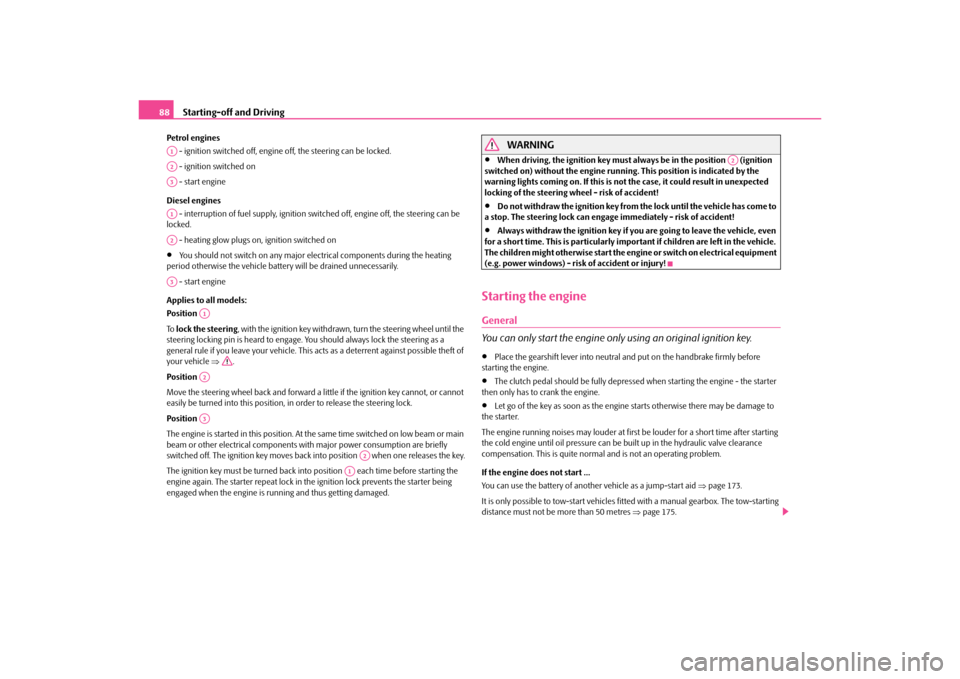
Starting-off and Driving
88
Petrol engines
- ignition switched off, engine off, the steering can be locked.
- ignition switched on
- start engine
Diesel engines - interruption of fuel supply, ignition swit ched off, engine off, the steering can be
locked.
- heating glow plugs on, ignition switched on
You should not switch on any major elec trical components during the heating
period otherwise the vehicle battery will be drained unnecessarily.
- start engine
Applies to all models:
Position
To lock the steering , with the ignition key withdrawn, turn the steering wheel until the
steering locking pin is heard to engage. Yo u should always lock the steering as a
general rule if you leave your vehicle. This acts as a deterrent against possible theft of
your vehicle .
Position
Move the steering wheel back and forward a little if the ignition key cannot, or cannot
easily be turned into this position, in order to release the steering lock.
Position
The engine is started in this position. At th e same time switched on low beam or main
beam or other electrical components wi th major power consumption are briefly
switched off. The ignition key moves back into position when one releases the key.
The ignition key must be turned back into position each time before starting the
engine again. The starter repeat lock in th e ignition lock prevents the starter being
engaged when the engine is r unning and thus getting damaged.
WARNING
When driving, the ignition key must always be in the position (ignition
switched on) without the engine running. This position is indicated by the
warning lights coming on. If this is not the case, it could result in unexpected
locking of the steering wh eel - risk of accident!
Do not withdraw the ignition key from the lock until the vehicle has come to
a stop. The steering lock can engage immediately - risk of accident!
Always withdraw the ignition key if you are going to leave the vehicle, even
for a short time. This is particularly important if children are left in the vehicle.
The children might otherwise start the engi ne or switch on electrical equipment
(e.g. power windows) - risk of accident or injury!
Starting the engineGeneral
You can only start the engine only using an original ignition key.
Place the gearshift lever into neutral and put on the handbrake firmly before
starting the engine.
The clutch pedal should be fully depressed when starting the engine - the starter
then only has to crank the engine.
Let go of the key as soon as the engine starts otherwise there may be damage to
the starter.
The engine running noises may louder at first be louder for a short time after starting
the cold engine until oil pressure can be built up in the hydraulic valve clearance
compensation. This is quite normal and is not an operating problem.
If the engine does not start ...
You can use the battery of anothe r vehicle as a jump-start aid page 173.
It is only possible to tow-start vehicles fi tted with a manual gearbox. The tow-starting
distance must not be more than 50 metres page 175.
A1A2A3A1A2A3
A1A2A3
A2
A1
A2
s2rc.book Page 88 Thursd ay, April 22, 2010 10:58 AM
Page 98 of 207

Passive Safety97
Using the system
Safety
Driving Tips
General Maintenance
Breakdown assistance
Technical Data
SafetyPassive SafetyBasic informationDriving the safe way
Passive safety measures reduce the risk of injury in accident situations.In this section you will find important info rmation, tips and notes on the subject of
passive safety in your vehicle. We have combined everything here which you should
be familiar with, for example, regarding seat belts, airbags, child seats and safety of
children. It is therefore important, in partic ular, to comply with the notes and warnings
in this section for your own interest and in the interest of those travelling with you.
WARNING
This chapter contains important information on how to use the vehicle for
the driver and his occupants. You will find further information on safety, which
concerns you and those travelling with you, in the following chapters of this
Owner's Manual.
The complete on-board literature should always be in the vehicle. This
applies in particular, if you rent out or sell the vehicle.
Safety equipment
The safety equipment is part of the occupant protection and it can
reduce the risk of injuries in accident situations.“Do not put at risk” your safety and the safety of those travelling with you . In the event
of an accident, the safety equipment can redu ce the risk of injuries. The following list
contains part of the safety equipment in your vehicle:
Three-point seat belts for all the seats*,
belt force limiter for front seats*,
belt tensioner for front seats*,
seat belt height adjuster for front seats,
front airbags*,
side airbags*,
anchoring points for child seat using the “ISOFIX” system,
head restraint adjustable for height,
adjustable steering column.
The specified safety equipment works togeth er, in order to optimally protect you and
those travelling with you in accident situat ions. The safety equipment does not protect
you or the people travelling with you, if you or your occupants adopt an incorrect
seated position or the equipment is not correctly adjusted or used.
For this reason you will be provided with information on why this equipment is very
important, how it protects you and the occupants, what should be observed when
using the equipment and how you and the peop le travelling with you can make full use
of the existing safety equipment. This Owner's Manual contains important warning
notes, which you and those travelling with you should pay attention to in order to
reduce a risk of injury.
Safety concerns everybody!
Before setting off
The driver is always fully responsibl e for his occupants and for the oper-
ating safety of the vehicle.For your own safety and the safety of the pe ople travelling with you, please pay atten-
tion to the following points before setting off:
Ensure that the lighting and the turn signal system are functioning properly.
Inspect the tyre inflation pressure.
Ensure that all the windows offer a good visibility to the outside.
Safely attach the items of luggage page 63, “Loading the luggage compartment”.
s2rc.book Page 97 Thursd ay, April 22, 2010 10:58 AM